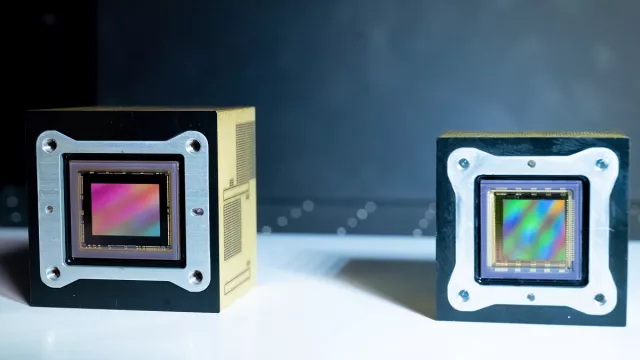Since 2015, CNES has been developing an innovative and versatile camera called CASPEX (CAmera for SPace EXploration). Today, CASPEX is operating on satellites in Earth orbit and on space exploration probes. Missions to the Moon, Mars and asteroids are already flying or set to fly the tiny camera with a promising future that boxes above its weight.
Key information
| Mission | Generic family of micro-cameras based on CMOS imaging sensors, adaptable to a broad spectrum of space missions |
|---|---|
| Domain | Science |
| Start date | First mission 27 February 2019 |
| Partners | 3DPlus |
| Where | OneWeb satellites (17 launched since 27 February 2019), EyeSat (18 December 2019), Mars 2020 Perseverance (30 July 2020), ELM/Rashid (11 December 2022) |
| Lifetime | Indefinite |
| Status | In operation |
Key figures
- 4-million-pixel resolution on first version of CASPEX
- 12-million-pixel resolution on new version
- 9 to 25 colours spectral resolution on new version
- 7 space projects flying CASPEX
Key milestones
- October 2026: CASPEX flown on MMX/IDEFIX
- 2026: CASPEX flown on ELM/Rashid 2
- 11 December 2022: CASPEX flown on ELM/Rashid
- 30 July 2020: CASPEX flown on Mars 2020/Perseverance
- 18 December 2019: CASPEX flown on EyeSat satellite
- 27 February 2019: First CASPEX launches on OneWeb satellites
- 2014: Start of CASPEX development
Project in brief
At a time when almost all imaging sensors operating in space were still based on charge-coupled device (CCD) technology, CNES started working in the 2000s on a new complementary metal-oxide-semiconductor (CMOS) technology that has since become pretty much the norm. It is used for example in mobile phone cameras and covers more than 99.9% of the imaging market today.
Leveraging large-scale industrial and commercial developments, today’s CMOS sensors significantly reduce pixel sizes to obtain better resolution without sacrificing signal quality.
But they still had to prove their ability to withstand the harsh temperature and radiation conditions of space, and the mechanical vibration environment of launch.
This has now been accomplished with CASPEX (CAmera for SPace EXploration), for which development work started in 2014 on EyeSat and SuperCam.
Vast range of applications
The first black-and-white version of CASPEX (4 million pixels) was soon adopted for space operations. Used today in star trackers by Sodern, a subsidiary of ArianeGroup, the cameras are on every satellite in the OneWeb global broadband Internet constellation. This version was also used on EyeSat, the first CNES student nanosatellite launched in 2019.
The colour (RGB) version of CASPEX is on the SuperCam instrument that the Perseverance Mars rover has relied on since landing in 2021 to remotely analyse the composition of the red planet’s soil and rocks.
This same colour version was on the Mohammed Bin Rashid Space Center’s Rashid 1 rover that rode with Japanese firm iSpace’s lander launched on 11 December 2022 atop a SpaceX Falcon 9 to explore the surface of the Moon. This unprecedented private-public partnership was set to put the first ever private lander on a celestial body, but unfortunately the mission crashed into the Moon on 25 April 2023.
Constantly evolving technology
The RGB version of CASPEX has also been chosen for the MMX mission’s rover set to explore Phobos, one of Mars’ two moons, in late 2024.
A more recent multispectral version of CASPEX, capable of distinguishing between 9 and 25 different colours, will be on the Emirati Rashid 2 rover planned to explore one of the Moon’s poles in 2025.
A new and enhanced version of CASPEX—with a resolution of 12 million pixels, better sensitivity and more image-processing capacity—capable of capturing 4K black-and-white, colour or polarized imagery—has recently been qualified and validated by CNES. It is set to equip a sovereign in-house CNES mission after 2024.
Lastly, even newer versions capable of extending the camera’s vision to the infrared are also in development. One thing is sure: we haven’t heard the last of this gem of French technology.
CNES’s role
The first CASPEX camera was developed in 2014 by CNES and 3DPlus.
CNES contacts
CASPEX Project Leader
Charles Yana
E-mail: charles.yana at cnes.fr
Head of sensor opto-electronics department
Cedric Virmontois
E-mail: cedric.virmontois at cnes.fr
Planets and Small Solar System Bodies subject matter expert
Francis Rocard
E-mail: francis.rocard at cnes.fr


